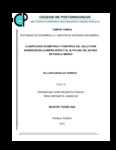Clasificación zoométrica y fenotípica del gallo para exhibición en la sierra norte y el altiplano del estado de Puebla, México
Abstract
El objetivo del trabajo fue analizar el sistema de cría del gallo para espectáculo y clasificar a las poblaciones en algunos lugares de la Sierra Norte y el Altiplano del estado de Puebla. La información se colectó de 11 criadores en una muestra de 507 gallos y 74 gallinas de los municipios de Puebla, Libres, Tlatlauquitepec y Cuetzalan. Para caracterizar a los gallos y gallinas, se registraron 24 medidas zoométricas corporales y diez variables fenotípicas en las que estuvieron incluidas el color del plumaje y peso vivo. Las aves medidas tenían de siete y ocho meses de edad. Los análisis estadísticos se realizaron mediante estadística descriptiva, análisis cluster y de varianza con el paquete estadístico SAS. Se detectaron dos tipos de galleros, los que producen pie de cría (72.7%) y los que mantienen sólo gallos para el espectáculo (27.3%). La crianza de las gallinas fue extensiva, se alimentan con granos de la región complementados con lo que recolectan en el traspatio. Los gallos, después de las siete semanas, se mantienen en jaulas, se alimentan con granos y alimento comercial. El análisis clúster identificó tres grupos: el gallo para espectáculo local (41%), gallos grandes de cruza con asiático (30.6%) y gallos pequeños de cruza con enano inglés (28%). El gallo local tiene peso mediano (2.0±0 kg) y un ancho de cabeza más pequeña (2.4±0 kg) en comparación de los dos grupos restantes. El gallo grande cruza con asiático tiene el mayor peso de los tres grupos (2.4±0.0 kg, p<0.001) y las mayores medidas del cuerpo. El gallo pequeño tiene las medidas zoométricas más bajas de los tres grupos. En la muestra de gallinas el plumaje predominante fue de tono perdiz y amarillo claro, y peso promedio de 1.5 kg. _______________ BODY TRAITS AND PHENOTYPIC CLASSIFICATION OF GAMECOCKS IN THE NORTHERN HIGHLANDS AND THE VALLEY OF PUEBLA STATE, MEXICO. ABSTRACT: The objective was to analyze the raising of gamecocks and to establish a classification of their populations in the Northern Highland and the Valley of Puebla, Mexico. The information was collected from 11 breeders in a sample of 507 roosters and 74 hens in the municipalities of Puebla, Libres, Tlatlauquitepec and Cuetzalan in the state of Puebla. Breeders were surveyed in order to get information of the production system. In order to characterize the roosters and hens, 24 zoometric traits and 10 phenotypic traits including plumage color and live weight were recorded. The animals were 7 to 8 month-old. The statistical analyses performed were descriptive statistics, cluster and variance analysis, using in all cases the SAS program. There were identified two types of breeders, those who raise breeding stock (72.7%) and the gamecock keepers (27.3%). Hen production is extensive and these animals are fed with grains and all that they can pick up from the backyard. The roosters are kept in cages and fed with grains and commercial feed. The cluster analysis identified three groups: the local gamecock (41%), big rooster crosses with Asian breeds (30.6%) and small rooster crosses with English dwarf (28%). The local rooster has medium live weight (2.02 ± 0.02 kg) and the smallest head width compared to the other two groups (2.4 ± 0.02 kg). The big roosters crosses with Asian breeds have the highest live weight of the three groups (2.4 ± 0.02 kg, p <0.001) and higher body traits measures. The small roosters have the smallest zoometric traits of the three groups. In the hen sample, the plumage color is partridge and light yellow color, and the average live weight is 1.5 kg.
Collections
- Tesis MC, MT, MP y DC [403]

